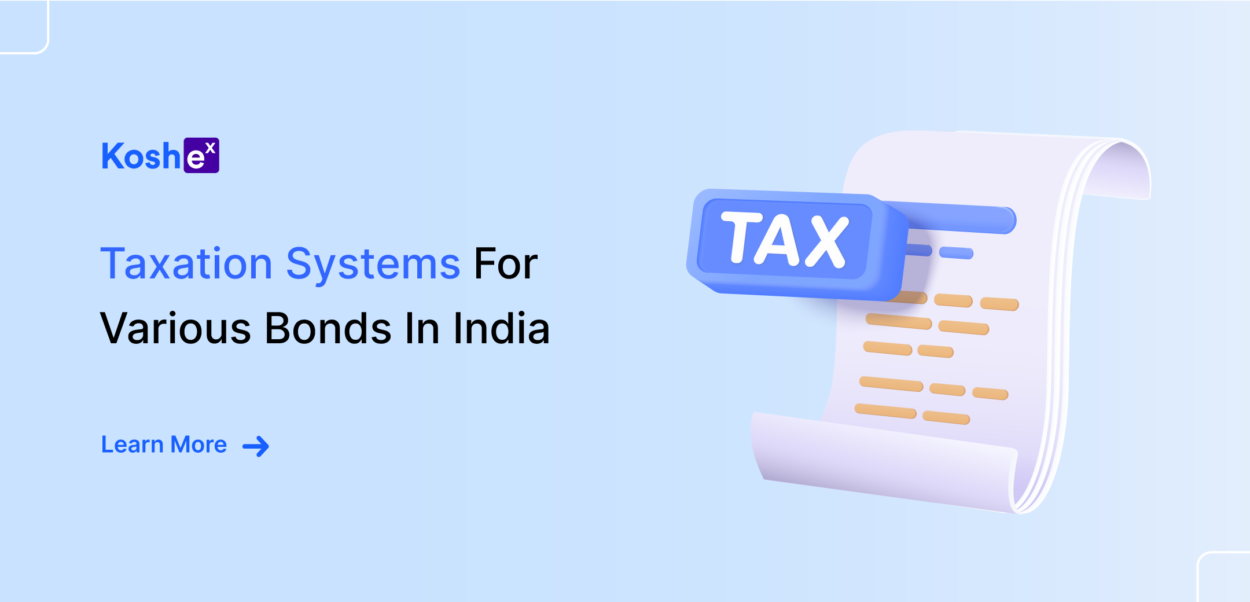Taxation Systems For Various Bonds In India
Bonds are one of the most ideal investment avenues for generating passive income. They are less volatile as compared to equity investments.
However, investors often face difficulties when it comes to the taxation of bonds in India. There are different types of bonds and each one of them is taxed differently in our country.
So, let’s understand the taxation systems of various bonds and how Koshex provides an opportunity to book higher gains.
Tax Applicable on Bonds in India
The taxation of bonds is governed by the Income Tax Act of 1961. Bonds are held by investors for investment purposes. Thus, they are classified as capital assets under the income tax law.
If the investor earns income by selling capital assets (bonds in this case), it is known as capital gains. However, if the investor incurs a loss due to the transfer of bonds, it shall be known as a capital loss.
There are two types of capital gains/losses based on the period for which the investor holds the capital asset. In the case of bonds, if the investor holds the bonds for more than 12 months, then the gain/loss arising from selling bonds after 12 months shall be called Long Term Capital Gains (LTCG) or Long Term Capital Loss (LTCL).
However, if the bonds are held for less than 12 months, the gain/loss arising from them shall be called Short Term Capital Gain (STCG) or Short Term Capital Loss (STCL).
However, in the case of unlisted bonds, the holding period shall be considered 36 months to determine the short or long-term capital gains.
Taxation Systems for Various Bonds in India
Bonds generate income in the form of interest and capital gains. The interest income shall be taxable as and when it is received by us. It shall be considered as ‘Income from Other Sources’ under the income tax law and charged at the tax rate applicable to us.
However, there are multiple provisions governing the gains arising from the selling of bonds, i.e., capital gains. Let’s understand how different types of bonds are taxed in India:
Regular Taxable Bonds
Regular taxable bonds generate a return in the form of interest rates and capital gains. While interest is a regular income, capital gains are generated when selling bonds.
The capital gains shall depend upon the holding period, i.e., the period for which we held the bond with us. Corporate bonds are an ideal example of regular taxable bonds.
In the case of listed bonds, the long-term capital gains shall be taxable at 10% without any indexation benefit. However, the short-term capital gains shall be taxable at the tax rate applicable to us.
However, in the case of unlisted bonds, the long-term capital gains shall be taxable at 20% without indexation benefits, while the short-term capital gains on unlisted bonds shall still be taxable at the tax rate applicable to us.
Tax-Free Bonds
Tax-free bonds are generally issued by the government or the public sector units. The funds raised by the government through the issue of these bonds are used for the purpose of various infrastructure and development projects.
It is the debt issued by the government; therefore, to pass on the benefits to the investors, these bonds are free from tax.
The returns generated from these bonds usually enjoy tax exemption. However, capital gains may be applicable on such bonds depending upon the terms and conditions of their issue.
The Reserve Bank of India may issue these bonds on behalf of the government.
Tax Saving Bonds
These bonds are usually issued to provide an opportunity to reduce the tax liability arising due to capital gains. Section 54EC provides tax benefits for investing in tax-saving bonds.
As per this section, tax on long-term capital gains arising from capital gains can be reduced by investing in certain tax-saving bonds as specified by Section 54EC.
The amount invested in these bonds is deducted from the capital gains. Only the balance capital gains are then subjected to tax.
The maximum amount of investment that can be made for claiming the deduction is up to Rs. 50 lakh. Some of these bonds include the bonds issued by the National Highway Authority of India (NHAI), Rural Electrification Corporation Limited (RECL), etc. The government can notify other bonds as well to claim deductions.
Zero-Coupon Bonds
In zero-coupon bonds, the coupon rate is the interest rate at which the bonds pay interest to us. Hence, a zero coupon bond will pay zero interest to us. So, how will we earn returns? These bonds are issued at a deep discount and redeemed at face value.
This allows us to make gains due to capital gains. As no interest rate is involved, there is no consequent tax liability due to interest.
The holding period to determine long-term or short-term capital gain is 12 months for zero-coupon bonds. Thus, the long-term capital gains shall be taxable at 20% without indexation benefit.
If we claim an indexation benefit, the tax rate shall be 10%. Further, in the case of short-term capital gains, zero coupon bonds shall be taxable at the tax rate applicable to us.
How Does Indexation Work in the Case of Bonds?
Indexation is the benefit extended by the government to long-term investors. The government has released a Cost Inflation Index (CII) for income tax law with 2001-02 as the base year having a value of 100. As the year progresses, the value of 100 increases considering the inflation.
This CII is used to determine the cost of acquisition for the taxability of the bond. Adjusting the cost of acquisition as per CII is known as indexation. Let’s understand this with a practical example.
Suppose Mr. A invested Rs. 10,000 in bonds in June 2012. He sold these bonds at Rs. 85,000 in September 2021. Thus, normally we can conclude that Mr. A made a profit of Rs.
75,000 from these bonds. While this is right in absolute terms, it fails to consider the implications of inflation. Thus, we need to use CII to give the effect of inflation.
The CII is 200 for the financial year 2012-13 (year of purchase) and 317 for the financial year 2021–22 (year of sale). Thus, the indexed cost of acquisition shall be Rs. 15,850 (Rs. 10,000 * 317 / 200).
Thus, the capital gains now will be Rs. 69,150. By accounting for inflation in the cost of acquisition, the investors are able to save on tax.
In a Nutshell
Taxation systems for various bonds may be different, but it is simple, and we only need to determine the holding period for our bond investment.
Before making any investment, it is important to understand the tax consequences as they directly affect our return. As India is a high-taxation country, we will have to pay tax at 20%-30% of our gains if we don’t plan wisely.
If we want to retain a good amount of earnings, we can focus on investing in high-return generating avenues. Koshex is an ideal investment platform that allows us to invest in over 5000+ funds.
Further, risk-averse investors can go for smart deposits, fixed deposits, or digital gold. These are some of the best investment alternatives to bonds that also ensure a steady flow of income to investors. It’s time to begin your investment journey with Koshex.
Frequently Asked Questions
Q: Are gains from the bond investment adjustable under the rebate provided under income tax?
A: Yes. If our income after considering gains from bond investment is below Rs. 5 lakhs, the bond investment can be adjusted under the rebate under income tax.
Q: What if we incur a loss on bond investment?
A: If our bond investment incurs a loss, we should see whether it is a long-term or short-term loss as per the holding period. While the long-term capital loss can be adjusted only against long-term capital gains, a short-term capital loss can be adjusted against both long-term and short-term capital gains.









Leave a Comment